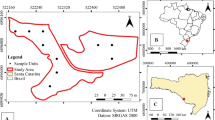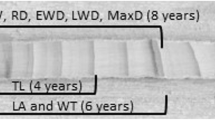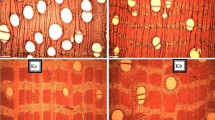Abstract
This study examined basic characteristics of stem wood produced in Pinus brutia Ten. reforestations in Northeastern Greece. Sixteen dominant trees growing at good and medium site qualities were felled at 14–22 years. Site quality classification was based on site quality surrogates and confirmed by using site index curves that were created for a neighbouring area. Discs were taken at three stem positions (base, middle, top) to study variations in ring width, latewood proportion and dry density. Generally, at both good and medium sites, ring width was found to increase towards the top of the stems while latewood proportion and dry density showed a negative relationship with stem height. Radial variability trends were similar at all heights, and at both sites, revealing a rapid increase for ring width in the first 3–6 annual rings followed by a decrease towards the bark, a gradual increase for latewood proportion and no specific change for dry density. Comparisons between wood material produced during the same growth period (2005–2001) showed statistically significant differences among sampling heights in all cases except for dry density in medium sites. At the base of the stems, mean ring width and dry density were significantly (P ≤0.05) higher at good sites (3.6 mm and 0.53 g/cm3) than at medium sites (3.0 mm and 0.50 g/cm3). However, the differences between the sites are of small magnitude and therefore have limited practical impact on wood processing. The availability of such data is useful in utilising small-dimension timber of brutia pine.
Zusammenfassung
In dieser Studie wurden die Eigenschaften von Pinus brutia Ten. Stammholz aus Wiederaufforstungsgebieten in Nordost-Griechenland untersucht. Sechzehn herrschende, 14 bis 22 Jahre alte Bäume aus guten bis mittelguten Standorten wurden gefällt. Die Standortgüte wurde auf Basis der Bodenqualität klassifiziert und durch Wachstumskurven eines benachbarten Gebietes bestätigt. Die Variation der Jahrringbreite, des Spätholzanteiles und der Rohdichte wurde an Stammscheiben aus dem unteren, mittleren und oberen Stammabschnitt untersucht. Dabei hat sich gezeigt, dass generell sowohl an guten als auch mittelguten Standorten die Jahrringbreite mit zunehmender Stammhöhe zunahm, wohingegen der Spätholzanteil sowie die Rohdichte mit der Stammhöhe negativ korreliert waren. In radialer Richtung variierten die Eigenschaften in allen Stammhöhen und auf beiden Standorten vergleichbar: die Jahrringbreite in den ersten 3–6 Jahrringen nahm stark zu und nahm dann ab. Der Spätholzanteil nahm leicht zu und die Rohdichte zeigte keine besonderen Veränderungen. Das im gleichen Zeitraum gebildete Holz (2005–2001) unterschied sich in den verschiedenen Entnahmehöhen statistisch signifikant mit Ausnahme der Rohdichte in den mittelguten Standorten. Die mittlere Jahrringbreite und Rohdichte am unteren Stammabschnitt waren an guten Standorten signifikant höher (3.6 mm und 0.53 g/cm3) als an mittelguten Standorten (3.0 mm und 0.5 g/cm3). Allerdings sind die Unterschiede zwischen den Standorten gering und haben daher einen begrenzten Einfluss auf die Holzverwendung. Die vorhandenen Daten sind hilfreich für die Erzeugung von Schnittholz mit kleinen Abmessungen aus Brutiakiefer.
Similar content being viewed by others
References
Barnes BV, Zak DR, Denton SR, Spurr SH (1998) Forest Ecology, 4th edn. Wiley, New York
Browicz K (1994) Chorology of trees and shrubs in south-west Asia and adjacent regions, Vol 10. Polish Academy of Sciences, Poznañ
Carmean WH (1972) Site index curves for upland oaks in the central states. Forest Sci 18(1):109–120
Critchfield WB, Little EL (1966) Geographic distribution of the pines of the world. USDA Forest Service, Miscellaneous Publication 991
Dafis SA (1986) Forest ecology. Giahoudi-Giapouli Publishers, Thessaloniki, p 443 (in Greek)
Dafis SA (1987) Ecology of Pinus halepensis and P. brutia forests. In: Proceedings of the 1st Scientific Conference on Pinus halepensis and Pinus brutia forests, Chalkis, 30 September–2 October 1987. Hellenic Forestry Society, Thessaloniki, pp 17–25
Frankis MP (1999) Pinus brutia. Curtis Bot Mag 16:173–184
Gezer A (1986) The silviculture of Pinus brutia in Turkey. CIHEAM 86(1):55–66
Hatzistathis A, Goudelis G, Zagas TH (1995) Growth and yield of Pinus brutia reforestations in relation with soil and physiographic factors. Scient Annals Dep For Man Nat Environ, Vol 38. Aristotelion University, Thessaloniki, Greece
Hildebrandt G (1960) The effect of growth conditions on the structure and properties of wood. In: Proceedings of the Fifth World Forestry Congress, Seattle, Wash, Vol 3, pp 1348–1353
Hilmi HA (1960) Density variation in Pinus brutia. Extr Rep Imp For Inst Oxford, England
Larson PR (1957) Effect of environment on the percentage of summerwood and specific gravity of Slash pine. Yale University, School of Forestry, Bulletin No 63
Lindström H (1997) Fiber length, tracheid diameter, and latewood percentage in Norway spruce: Development from pith outwards. Wood Fiber Sci 29:21–34
Milios E (2004) The influence of stand development process on the height and volume growth of dominant Fagus sylvatica L. s.l. trees in the central Rhodope Mountains of north-eastern Greece. Forestry 77(1):17–26
Newberry JD (1991) A note on Carmean’s estimate of height from stem analysis data. Forest Sci 37(1):368–369
Oliver CD, Larson BC (1996) Forest stand dynamics (update edition). Wiley, New York, p 520
Panshin AJ, de Zeeuw C (1980) Textbook of wood technology. McGraw-Hill, New York, p 722
Pantelas V (1986) The forests of brutia pine in Cyprus. CIHEAM 86(1):43–46
Paraskevopoulou A (1987) Comparison of wood characteristics of aleppo and brutia pine from reforestations with exotic softwoods. In: Proceedings of the 1st Scientific Conference on Pinus halepensis and Pinus brutia forests, Chalkis, 30 September–2 October 1987. Hellenic Forestry Society, Thessaloniki, pp 362–388
Raiskila S, Saranpää P, Fagerstedt K, Laakso T, Löija M, Mahlberg R, Paajanen L, Ritschkoff AC (2006) Growth rate and wood properties of Norway spruce cutting clones on different sites. Silva Fenn 40(4):247–256
Raymond CA, Dickson R, Rowell D, Blakemore P, Clark N, Williams M, Freischmidt G, Joe B (2004) Wood and fibre properties of dryland conifers. RIRDC Publication No. 04/099, Kingston ACT
Rinn F (2003) TSAP-Win User Reference Manual. Rinntech, Heidelberg
Roussodimos GC, Petinarakis JH (1994) The wood of hard pine (Pinus brutia Ten.). Scient Annals Dep For Man Nat Environ, Vol 37. Aristotelion University, Thessaloniki, Greece
Saranpää P (2003) Wood density and growth. In: Barnett JR, Jeronimidis G (eds) Wood quality and its biological basis. Biological Sciences Series. Blackwell & CRC Press, London & Boca Raton, FL., pp 87–117
Smith DM, Larson BC, Kelty MJ, Mark P, Ashton S (1997) The practice of silviculture: applied forest ecology. Wiley, New York, p 537
Tsoumis G (1991) Science and technology of wood: structure, properties, utilization. Van Nostrand Reinhold, New York
Tsoumis G, Panagiotidis N (1980) Effect of growth conditions on wood quality characteristics of black pine (Pinus nigra Arn.). Wood Sci Technol 14:301–310
Zobel B, van Buijtenen J (1989) Wood variation: its causes and control. Springer Series in Wood Science. Springer, New York
Author information
Authors and Affiliations
Corresponding author
Rights and permissions
About this article
Cite this article
Adamopoulos, S., Milios, E., Doganos, D. et al. Ring width, latewood proportion and dry density in stems of Pinus brutia Ten. . Eur. J. Wood Prod. 67, 471–477 (2009). https://doi.org/10.1007/s00107-009-0345-x
Received:
Published:
Issue Date:
DOI: https://doi.org/10.1007/s00107-009-0345-x




